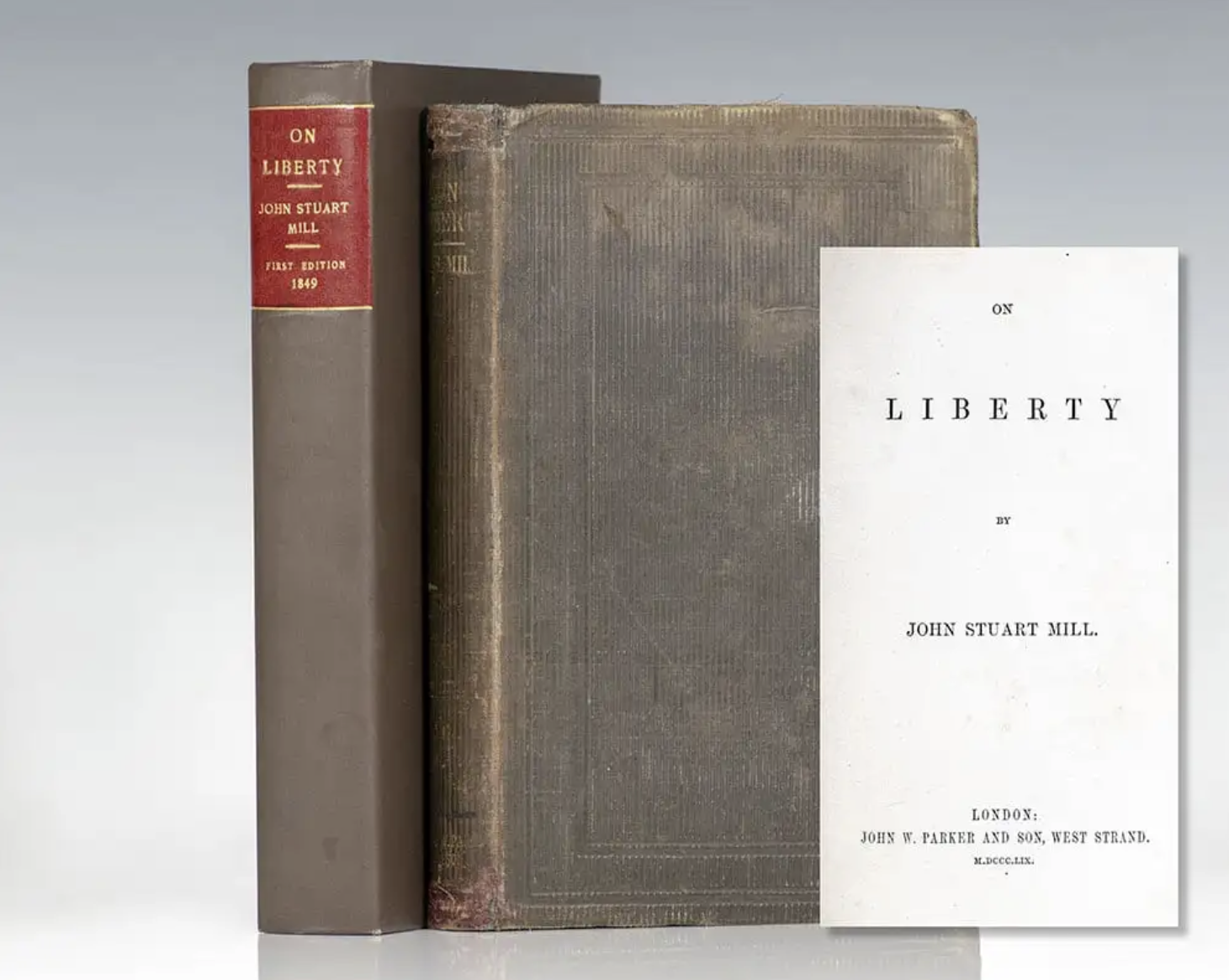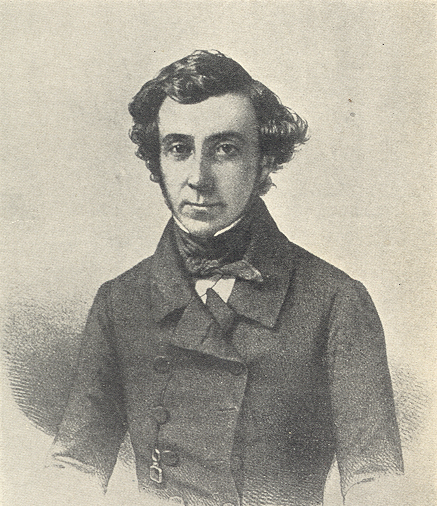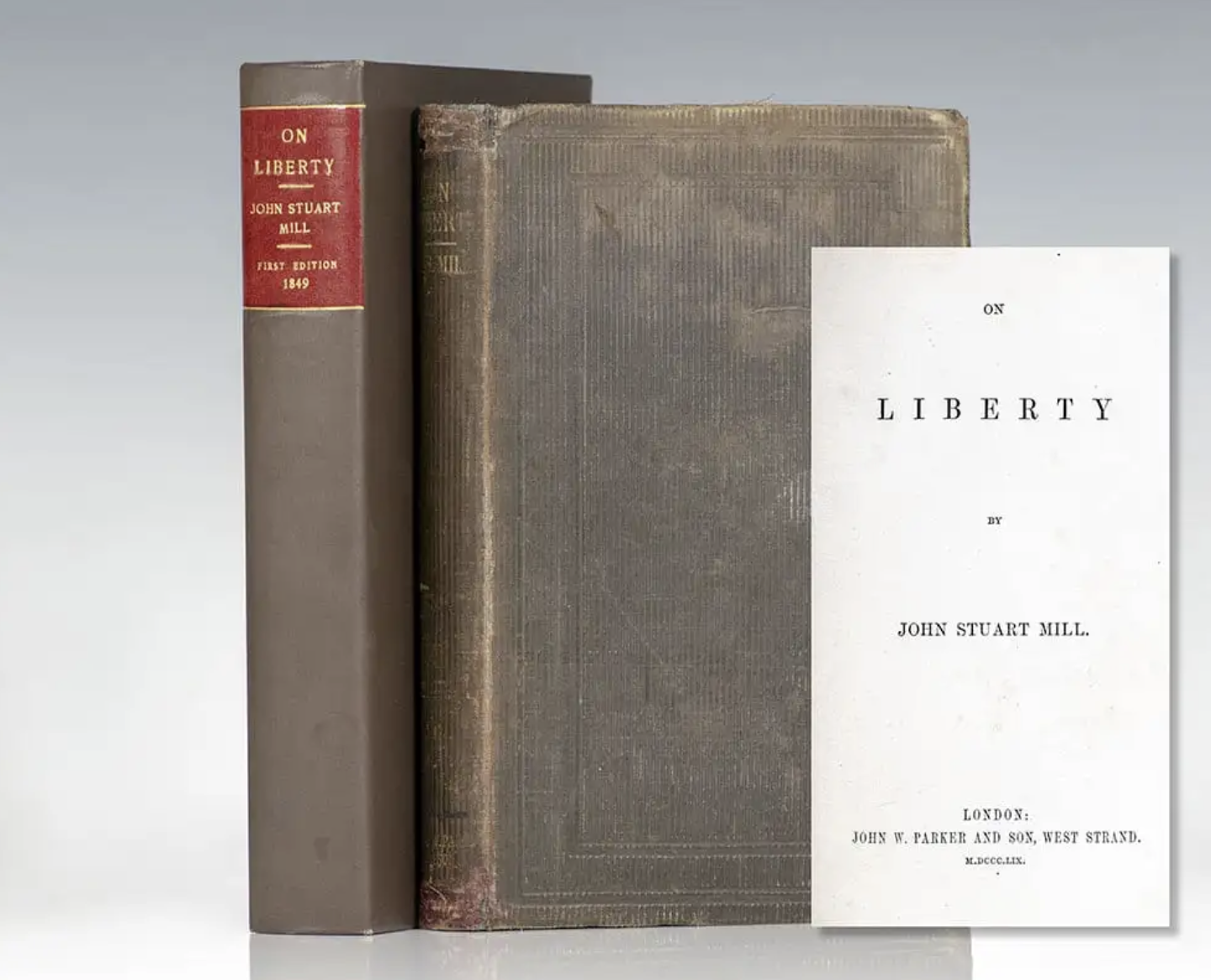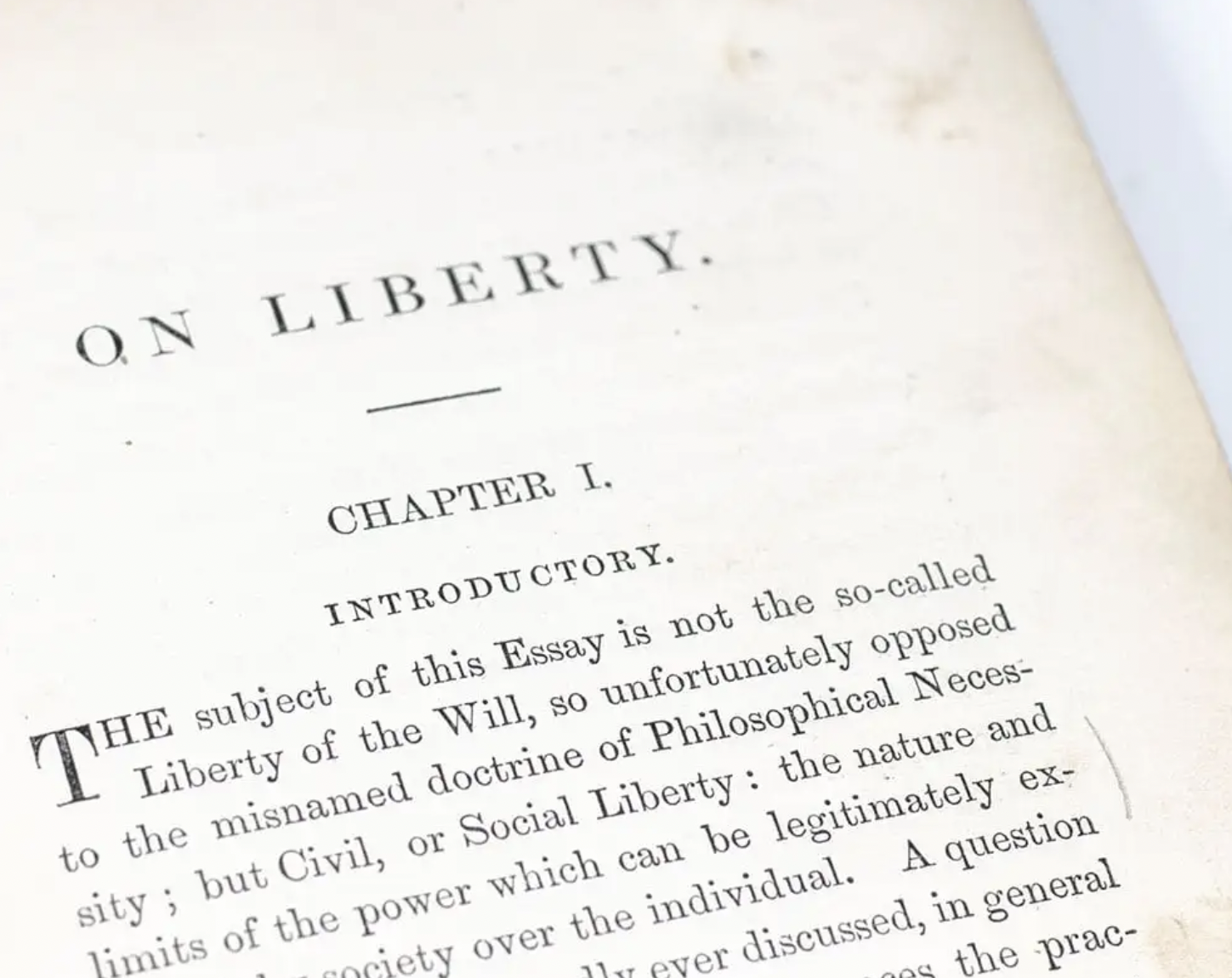I prepared this research paper (about 1500 words) for HIST 31892 (Intellectual Life in the Nineteenth Century Britain) at the University of Manchester. I owe a great deal to Dr. Emily Jones for her kind, helpful, and supportive approach.
Introduction
On Liberty is a philosophical text written by one of the leading Utilitarian intellectuals, John Stuart Mill, in 1859. The extract is this essay’s third chapter, Of Individuality, as One of the Elements of Well-Being. Viewing the rise of the masses at the socio-political level as destructive, Mill aimed to develop a moral character based on spontaneity and individuality ensured by liberty. Besides, he outlined negative aspects of public opinion and customs to endanger individual development, drawing limits for social pressure except harming other individuals with an immoral goal. Writing for a diverse variety of individuals in Britain, from ordinary students to Victorian intellectuals, Mill conceptualized liberty as a moral doctrine.

To begin with arguments, Mill maintained that individuals should always be free unless they deliberately harm others since liberty develops their character that is ‘the chief ingredient of individual and social progress’[1] Afterward, he contends that conforming to custom destroys individuality since its secret lies in making freely individual choices. Criticizing conformity and supporting spontaneity, Mill opposed Calvinism due to its impeding principles on individuality. However, the loss of individuals due to the power of the masses nurtures mediocrity, not individuality, arguing that
‘Individuality is the same thing with development, and that is only the cultivation of
individuality which produces…well-developed human beings’ [2].
Besides, public opinion and custom’s despotism prevent liberty by asserting its principles to make people mediocre masses. Mill claimed that what made England and Europe great was its adherence to individuality, comparing them with China in its customary and stationary system. He concluded that individuality should be protected because only it can eliminate Chinese-like uniformity and guarantee diversity.
Stylistic Features
As for language and style, Mill’s prose is composed of clear sentences and repetitive words without romantic and poetic influences. Ryan mentions that On Liberty was lucid, transparent, and simple but deliberately repetitive since Mill attempted to permeate English society by repeating the same concepts and topics [3]. Additionally, he uses similitudes like sheep and machines to identify the masses, trees to define individuals, ‘the salt of the earth’ to indicate geniuses, or ‘a stagnant pool’ to display the world in their absence. He also recounts figures from the ancient world like the usage of Pericles to illustrate a moral character in this extract. Riley disputes that Pericles’s uncustomary love affair with Aspasia influenced Mill regarding his unconventional affair with Harriet [4]. In this sense, Mill dedicated On Liberty to Harriet after her death, highlighting her contribution.

The Third Chapter: The Heart of On Liberty
In a broader sense, On Liberty’s other chapters easily fit into this third chapter since they have a meaningful connection with the extract, analyzing the freedom of speech and discussion with limiting social authority. The extract’s beginning recalls the previous chapter regarding vital freedoms and its end reminds of the next chapter on restricting social coercion. Furthermore, the book can be situated in a series of intellectual debates around defining and implicating liberty in the Western world. Many intellectuals examined liberty’s place in different social spheres, witnessing the French and American revolutions. The extract refers to Humboldt and Alexis de Tocqueville’s (on the right) ideas in this framework. While Humboldt opposed social coercion, Tocqueville offered individuality as the antidote against uniformity’s hazards; hence, they influenced Mill’s intellectual and philosophical roadmap [5].



Disliking or Defending Mill: Shifting Intellectual Attitudes towards On Liberty
On the other hand, British intellectuals responded to On Liberty in changing ways. Challengers emphasized the extract’s several assumptions. H. T. Buckle and Walter Bagehot wrote that individuality was more widespread thanks to liberty’s progress in people’s minds as a significant concept. Thomas Babington Macaulay (on the left) asserted that there was no indication of individuality’s disappearance, saying “he is really crying “fire” in Noah’s flood” [6]. Mill responded that Macaulay’s works were not history books [7]. Thomas Carlyle (middle) condemned that ‘the crowing…death-stricken spirit [Mill], now making such great signs…and…the world wondering after it.’[8] Mill’s criticism of his notion of hero-worship in the extract can explain his dissatisfaction. The most elaborated counteract to Mill is J. F. Stephen’s Liberty, Equality, and Fraternity. Stephen conceptualized that ‘liberty was…like fire it was both good and bad” according to conditions’[9]. Mill viewed Stephen’s verdicts as brutal and superficial.
In this respect, Mill’s leading proponent is Morley’s On Compromise. Morley aimed to construct a moral character and respond to Stephen, regarding himself as proceeding Mill’s work [10]. Though M. Arnold agreed with Mill on building moral character, he preferred wisdom and virtue to individuality as the basis in confronting conformity. Besides, British Idealists bolstered Mill regarding the cultivation of individuality through liberty but they identified liberty as a social concept provided by the state’s intervention. On Liberty’s fluctuating reputation after Mill’s death positively shifted in the Edwardian and following periods. For instance, Thomas Hardy remarked that people knew the book by heart at universities [11]. Particularly, leading progressive politicians and intellectuals used it as a guideline. Briefly, this work can be classified as a crucial part of the wider debate on individuality and liberty.
The Prominence of On Liberty in Victorian and Contemporary Contexts
 As for its evaluation, this extract is historically significant in many aspects. Initially, historiographical debates regarding On Liberty mostly emerge from its third chapter. Robson emphasizes that the essay’s clearest statements are presented in this chapter [12]. For Harrison, the extract consolidates other issues in the book in a holistic shape. It is ‘the crucial, central, third chapter of On Liberty, the hinge on which the whole work turns.’[13] Additionally, the extract is related to Carlyle’s refusal of utilitarianism in Past and Present can account for his dissatisfaction with On Liberty for other reasons as underlined above. On Compromise is associated with the extract since Morley continued it with the inclusion of religious practices. Macaulay’s History argued that liberty had been more common thanks to the Constitution, unlike Mill’s views.
As for its evaluation, this extract is historically significant in many aspects. Initially, historiographical debates regarding On Liberty mostly emerge from its third chapter. Robson emphasizes that the essay’s clearest statements are presented in this chapter [12]. For Harrison, the extract consolidates other issues in the book in a holistic shape. It is ‘the crucial, central, third chapter of On Liberty, the hinge on which the whole work turns.’[13] Additionally, the extract is related to Carlyle’s refusal of utilitarianism in Past and Present can account for his dissatisfaction with On Liberty for other reasons as underlined above. On Compromise is associated with the extract since Morley continued it with the inclusion of religious practices. Macaulay’s History argued that liberty had been more common thanks to the Constitution, unlike Mill’s views.
Nowadays, intellectual historians evaluate On Liberty as a cornerstone in moral development. For Collini, the book is ‘his famous map of the moral sciences, the Mercator’s projection of nineteenth-century thought in this area’[14] Appreciating him as a distinctive reformer, Jones comments that Mill intended to supplement moral development’s seeds by opening a gulf between individuality and uniformity [15]. For Harrison, On Liberty prepared the human mind’s moral science within a logical framework as a founding text of Victorian liberalism [16]. In Capaldi’s view, the essay reshaped Western morality, surpassing a philosophical essay on a particular topic [17]. Briefly, secondary sources focus on morality to understand the book in similar approaches. Therefore, the historical arguments of modern historians accurately overlap the extract’s main themes in general. Besides, secondary scholarship agrees with many other topics like Harriet Mill’s influence on the book as Mill’s wife and closest supporter. As a crucial point, many contemporary intellectuals did not mention her role in the book.
Concluding Remarks
To sum up, On Liberty has a substantial place in British intellectual history apart from its philosophical prominence as Mill’s magnum opus. It has aroused a vast array of mixed reactions in both contemporary and secondary contexts. In this respect, its positive evaluation has increased from primary to secondary scholarship with the rise of individualist ideas among many intellectuals from politicians to philosophers in the twentieth century. As Mill wrote,
‘On Liberty is likely to survive longer than anything else that I have written’ [18].
Its significance lies in redefining liberty as a means of acquiring individuality and shaping morality in a consistent and complete character. This redefinition went beyond the Victorian intellectual atmosphere to a global extent, inspiring different intellectuals and intellectual historians in understanding liberty’s implications.
Bibliography
Capaldi, Nicholas, John Stuart Mill: A Biography (Cambridge: Cambridge University Press, 2004)
Collini, Stephen, ‘The Tendencies of Things: John Stuart Mill and The Philosophic Method’, in That Noble Science of Politics: A Study in Nineteenth-Century Intellectual History, ed. by Stephen Collini, Donald Winch, and John Burrow (Cambridge: Cambridge University Press, 2008), pp.127–161
Mill, J. Stuart. On Liberty, (Harmondsworth: Penguin Books, 1985)
Jones, H.S. ‘Economic Men: Political Economy and Political Thought’ in Victorian Political Thought (Red Globe Press, 2000), pp. 1-42
Jones, H.S. ‘J.S. Mill as Moralist’, Journal of the History of Ideas 53 (Philadelphia, PA: The University of Pennsylvania Press, 1992), pp. 287-308
Harrison, Joss, ‘John Stuart Mill, Mid-Victorian, in The Cambridge History of Nineteenth-Century Political Thought, ed. by Gareth Stedman Jones (Cambridge: Cambridge University Press, 2011), pp. 295–315
Irwin, T.H, ‘Mill and the Classical World’, in The Cambridge Companion to Mill, ed. by John Skorupski (Cambridge: Cambridge University Press, 1998), pp. 423–463
Nicholson, Peter, ‘The Reception and Early Reputation of Mill’s Political Thought’, in The Cambridge Companion to Mill, ed. by John Skorupski (Cambridge: Cambridge University Press, 1998), pp. 464–96
Riley, Jonathan, Routledge Philosophy Guidebook to Mill: On Liberty (London: Routledge Press, 1998)
Ryan, Alan, ‘Mill in a Liberal Landscape’, in The Cambridge Companion to Mill, ed. by John Skorupski (Cambridge: Cambridge University Press, 1998), pp. 497–540
Robson, John, ‘Civilization and Culture as Moral Concepts’, in The Cambridge Companion to Mill, ed. by John Skorupski (Cambridge: Cambridge University Press, 1998), pp. 338–71
Footnotes
[1] J. S. Mill, On Liberty, (Penguin Books, 1985), p. 56.
[2] Mill, On Liberty, p. 63.
[3] Alan Ryan, ‘Mill in a Liberal Landscape’, in The Cambridge Companion to Mill, ed. by John Skorupski (CUP, 1998), pp. 497–540 (p. 512).
[4] Jonathan Riley, Routledge Philosophy Guidebook to Mill: On Liberty (Routledge Press, 1998), p.83.
[5] Stephen Collini, ‘The Tendencies of Things: John Stuart Mill and The Philosophic Method’, in That Noble Science of Politics, ed. by Collini, Winch, and Burrow (CUP, 2008), p. 159.
[6] Mill, p. 38.
[7] Collini, ‘The Tendencies of Things’, p. 145.
[8] Nicholas Capaldi, John Stuart Mill: A Biography (CUP, 2004), p. 291
[9] H.S. Jones, ‘J.S. Mill as Moralist’, Journal of the History of Ideas 53 (The University of Pennsylvania Press, 1992), pp. 287-308 (p. 300).
[10] Jones, ‘J.S. Mill as Moralist’, p. 301.
[11] Mill, p. 45.
[12] John Robson, ‘Civilization and Culture as Moral Concepts’, in The Cambridge Companion to Mill, ed. by Skorupski (CUP, 1998), pp. 338–71 (p. 343).
[13] Joss Harrison, ‘John Stuart Mill, Mid-Victorian’, in The Cambridge History of Nineteenth-Century Political Thought, ed. by Jones (Cambridge University Press, 2011), pp. 295–315 (p. 308).
[14] Collini, ‘The Tendencies of Things’, p. 130.
[15] H.S. Jones. ‘Economic Men: Political Economy and Political Thought’ in Victorian Political Thought (Red Globe Press, 2000), p. 36.
[16] Harrison, ‘John Stuart Mill, Mid-Victorian’, p. 296.
[17] Capaldi, John Stuart Mill, p. 266.
[18] Capaldi, John Stuart Mill, p. 266.


